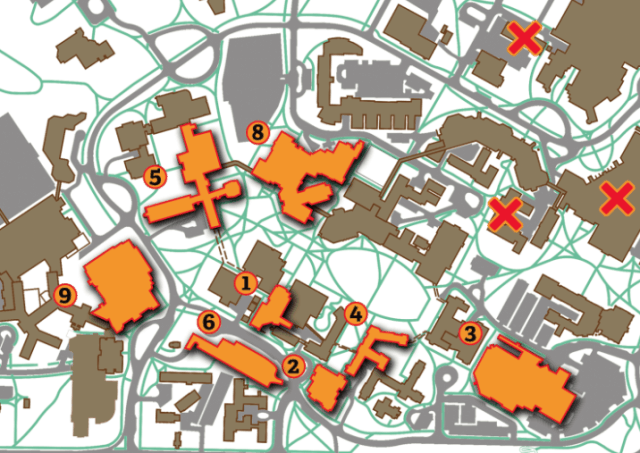The University of Saskatchewan has learned from past mistakes.
Campus Safety sent an email notification to the campus community the morning of Jan. 16 following a sexual assault that reportedly took place late the night before at the Luther Residence at the north end of campus.
The email described the alleged assailant as a caucasian male in his late 50s, five-foot-nine to six feet tall with brown hair and brown eyes, thick eyebrows and large hands. The StarPhoenix reported that the assailant and the victim had met several times before the incident, which remains under investigation by the Saskatoon Police Service.
The prompt campuswide announcement marked a reversal from the school’s handling of a sexual assault last year.
Last February the university was criticized by the campus community for informing the public of a sexual assault at the McEown Park residence six weeks after the incident occurred. The backlash sparked several reforms to the university’s communications procedures.
Ivan Muzychka, the university’s associate vice-president of communications, said the university discussed the event with several members of the campus community.
“The university committed to reporting crime more proactively to the campus community — especially violent incidents and assaults, sexual assaults,” Muzychka said.
When a sexual assault occurred last May near a parking lot off Seminary Crescent, the campus community was informed of the incident the next day.
[box type=”info”]Click here to view our interactive map of crime hotspots on campus.[/box]Last week Campus Safety informed the community of a reported sighting of a “long-barrelled shot gun.” After reviewing surveillance footage from a Spruce Hall residence, Campus Safety sent an email clarifying that the gun was actually an air rifle.
Campus Safety immediately followed the notification up with a second email when the woman spotted holding the gun contacted officers.
Campus Safety spokesperson Harold Shiffman says the university is modelling its new communications system after American universities, and pointed to the Clery Act as the university’s example.
The Clery Act, named after Lehigh University student, Jeanne Clery, who was raped and murdered in her residence in 1986, requires post-secondary schools across the U.S. to inform students, faculty and staff immediately about crime on or near their campus.
Shiffman says Lehigh University didn’t inform the public about Clery’s death “for a long period of time.”
“It went to their supreme court and they said, ‘You are a university, you have to report it.’ ”
The U of S launched USafe, a text messaging and emailing service that alerts subscribers of situations of immediate danger on campus, shortly after receiving criticisms for their six-week delay in informing the public of a sexual assault.
“If we believe there is an immediate threat to campus safety — and that could be a tornado, or the classic example we use is ‘The tiger in the Bowl’ — we want something to go out very quickly,” Muzychka said.
“If there is a reported assault or a sexual assault that occurs on the campus or even near the campus, we will issue a campus alert to let the community know that this has happened,” he added. “If there is no immediate threat, we can put it out as a campus notification” through PAWS or through email.
Shiffman said Campus Safety recently launched a crime log to balance alerting the community of reported crimes and not overdoing notifications.
“Obviously we can’t notify students of everything that happened — it will be like crying wolf,” Shiffman said.
The log, which dates back to Jan. 1 of this year, lists all reported crimes on campus, where the crimes occurred, at what times they occurred, when they were reported as well as the reported crime’s case number.

According to records kept by Campus Safety, this image shows eight of the nine locations on campus with the highest amounts of reported crime from 2007-12. The “X”s mark locations where sexual assaults have been reported.
In May 2012, a sexual assault occurred in a parking lot just off Seminary Crescent.
A 22-year-old man was arrested and pleaded guilty to the offence in a provincial court May 31.
Campus Safety marked the Education Building as the location of the assault.
Shiffman, Campus Safety’s spokesperson, said that officers elected to connect the incident to the Education Building because they had found video of the perpetrator escorting the victim out of the building.
“It was the beginning of that incident,” Shiffman said. “An incident that continues throughout different locations is difficult to pinpoint.
“The actual assault most likely occurred in E lot.”
Shiffman said it is up to individual officers to input crime reports into Campus Safety’s computer system and that often the location of a service call can get mixed up with the location of an incident.
“Let’s say you were assaulted by another student off campus. The incident might get associated with a location but maybe that location is your residence because that’s where you called us, or maybe it’s the Campus Safety building because that’s where you came to report it,” Shiffman said, pointing to an assault recorded at McEown Park that he believes occurred off campus.
“You need to be careful with your inferences,” Shiffman said of reading the Sheaf’s map of reported crimes, “but it doesn’t necessarily mean every single one of these calls happened off campus or that they are incorrect. It would be a very small subset of these numbers that are not 100 per cent.”
Brent Penner, the director of Campus Safety, said the crime log will help improve how the university tracks the locations of reported crimes.
He also said that Campus Safety needs to be more aware of how they record reported crimes.
“Moving forward we need to be more cognizant ourselves, within our own department, of saying ‘This guy’s reporting the crime to me here but it actually occurred at this location.’ ”
—
Image: Supplied
Map: Bryn Becker/The Sheaf